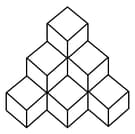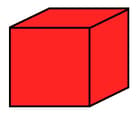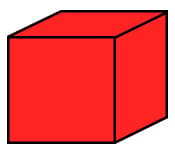Cube Cutting
Important Questions on Cube Cutting
A cube of side is divided into smaller cubes of side . What will be the total number of middle cubes?
The six faces of a cube is painted with black, brown, green, red, white and blue in such a way that.
. Red is on the face opposite to black
. Green is between red and black
. Blue is on the face adjacent to white
. Brown is on the face adjacent to blue
. Red is on the bottom face
Which three colours appear on the edge of the cube?
The six faces of a cube is painted with black, brown, green, red, white and blue in such a way that.
. Red is on the face opposite to black
. Green is between red and black
. Blue is on the face adjacent to white
. Brown is on the face adjacent to blue
. Red is on the bottom face
Which colour is on the face opposite to green?
Read the following information carefully to answer the questions that follow.
A cube is coloured red on two opposite faces, blue on two adjacent faces, and yellow on two remaining faces. It is then cut into two halves along the plane parallel to the red faces. One piece is then cut into four equal cubes and the other one into equal cubes.
How many cubes will not have any red faces?
Read the following information carefully to answer the questions that follow.
A cube is coloured red on two opposite faces, blue on two adjacent faces and yellow on two remaining faces. It is then cut into two halves along the plane parallel to the red faces. One piece is then cut into four equal cubes and the other one into equal cubes.
How many cubes will not have any coloured faces?
A cube is coloured red on all of its faces. It is then cut into smaller cubes of equal size. The smaller cubes, so obtained are now separated.
How many smaller cubes have one surface painted with red colour?
A solid cube of inches has been painted red, green and black on pairs of opposite faces. It has been cut into one-inch cubes. How many cubes have only two faces painted?
All faces of a cube are painted with different colours. Red and blue colours are on the opposite faces while the blue colour is in between the yellow and green colours. The colour on the face opposite the green colour is:
A cube having side is divided into smaller cubes of equal volume. Find the edge of smaller cubes.
If a cube of side is divided into smaller cubes of side, then find the total number of inner central cubes.
A cube of side is divided into smaller cubes of side . What will be the total number of middle cubes?
Count the number of cubes in the given figure.

A cube is red on all of its faces. It is then cut into small cubes of equal size. The smaller cubes so obtained are now separated.

How many smaller cubes have only three surfaces painted with red colour?
A cube is red on all of its faces. It is then cut into small cubes of equal size. The smaller cubes so obtained are now separated.

How many smaller cubes will have at least two surfaces painted with red colour?
A cube is red on all of its faces. It is then cut into small cubes of equal size. The smaller cubes so obtained are now separated

How many smaller cubes have no surface coloured?
If a cube of side is divided into smaller cubes of side, then find the total number of inner central cubes.
A cube of side is divided into smaller cubes of side . What will be the total number of middle cubes?
A cube is coloured red on all its faces. It is then cut into smaller cubes of equal size. The smaller cubes so obtained are separated. How many cubes have no faces coloured?
How many smaller cubes of side can be formed with a solid cube of side?
Each of the six different faces of a cube has been coated with a different colour, i.e., V, I, B, G, Y and O. Following information is given.
. Colours Y, O and B are on the adjacent faces.
. Colours I, G and Y are on the adjacent faces.
. Colours B, G and Y are on the adjacent faces.
. Colours O, V and B are on the adjacent faces.
Which is the colour of the face opposite to the face coloured with O?

